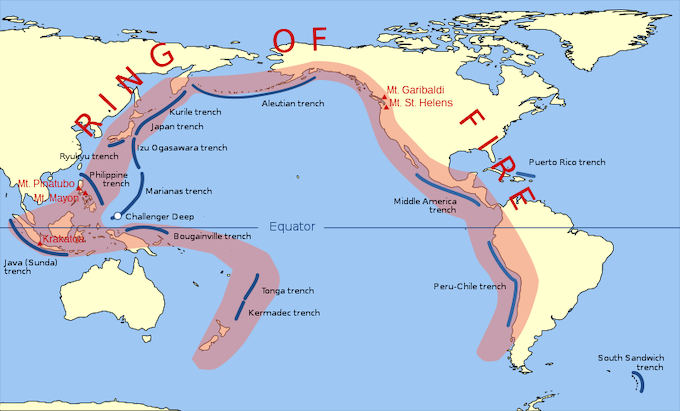We’ve experienced quite a few earthquakes since arriving in Aotearoa New Zealand only 6 months ago! Some big, some small, some barely noticeable at all. One even made headlines all the way back in the Netherlands. Triggering heaps of messages to ask us if we’re alright. Well, yes, we are! I’ve been reading a bit about this fascinating subject since we first got shaken up. I thought I would write a post about it sharing some of the things I’ve learned. I’ll probably revisit this one in the future as there’s way more to earthquakes (in New Zealand and beyond) than I included now.

Earthquakes
New Zealand is part of the Ring of Fire – a horseshoe-shaped belt about 40,000 km long and up to 500 km wide where many volcanic eruptions and earthquakes occur. The Ring of Fire is a direct result of plate tectonics under and around the Pacific Ocean. It contains about 750-915 volcanoes (2/3 of the world’s total) and about 76% of the Earth’s seismic energy is released as earthquakes in the Ring of Fire. About 90% of the Earth’s earthquakes and about 81% of the world’s largest earthquakes occur along the Ring of Fire. A pretty active area I would say!
The Alpine Fault is the big geological fault that runs across the length of New Zealand. It forms the boundary between the Pacific Plate and the Indo-Australian Plate. The Southern Alps in the South Island of New Zealand were lifted up on this fault over the last 12 million years in a series of earthquakes. The last major earthquake along the Alpine Fault was in 1717 AD, and the probability of another one occurring within the next 50 years is estimated at about 75 percent, with about a 82% chance that such an earthquake would be a magnitude 8 or higher.
Measuring earthquakes, not only in New Zealand
But what does that mean, ‘magnitude 8’? We all know that’s considered ‘high’, but coming from the Netherlands where earthquakes are a rare occurrence it’s hard to understand what it means to live in a shaky country like New Zealand. Since 1904 there were 7 earthquakes with a magnitude of 4.0 or higher in the Netherlands – the last one was in 1992: 5.8 magnitude earthquake in Roermond.
The ‘Richter’ magnitude scale is what we got taught about in high school. But that is not a very accurate scale as it’s developed for a specific region only (there’s a whole, slightly confusing, article about this on Wikipedia). The Moment Magnitude Scale is what’s used nowadays (although everybody keeps referring to Richter). The scale is logarithmic, which means an increase of one step on the scale means a 32x increase in the amount of energy released. An increase of two steps corresponds to a 1000x increase in energy. So, an earthquake of 7.0 magnitude contains 1000x more energy than one of 5.0. The higher you go, the worse it gets.
Three earthquakes in one month: welcome to New Zealand!
In February 2023 we had three earthquakes that were quite strong:
- Wed 15/2 at 19.38h – 50km north-west of Paraparaumu (North Island), depth 54km, magnitude 6.0
We were out for dinner, sitting in a full restaurant – shaking for a short period but nobody responded. Later someone said New Zealanders only respond when stuff starts falling off of the walls. It was quite interesting to notice that Dutch newspaper De Telegraaf wrote an article about the earthquake as it happened just after cyclone Gabrielle passed the country – even though 6.0 is quite strong, it wasn’t so bad it caused any serious issues. Also, the part of the country that was devastated by the cyclone was pretty much unaffected by the earthquake. Slightly overly dramatic title we would say…
- Wed 22/2 at 10.11h – 47km west of Blenheim, depth 47km, magnitude 4.9
I was at work, on my own in my office, and my chair (on wheels) started to move around. At first I was unsure whether it was a big truck passing or an earthquake. However, after checking it was confirmed not to be a truck!
- Tue 28/2 at 20.26h – 10km south-east of Picton, depth 28km, magnitude 4.8
We were at home, I was inside writing a letter and Xander was outside hanging up the laundry. This one was interesting, because we heard rumbling before it started to shake. It was quite intense but short again. Xander saw the shed shake (and also thought it was a truck at first). He said it was quite a different experience outside compared to inside.
Life goes on
Although these were not really ‘big’ earthquakes, we did feel them. It will take some getting used to, as smaller earthquakes happen frequently here. In total there’s about 150 earthquakes strong enough to be felt in New Zealand each year.
Yet it also depends on where you are (you barely feel them in a car/on the bike) and where the earthquake is (land, sea, how deep etc). There’s also dozens of earthquakes we don’t feel: for example, yesterday there were 6 earthquakes measured but they were all considered weak, unnoticeable for most of us.
We use an app to track the quakes, and you can also share it if you feel one. It’s called GeoNet. It keeps track of all the earthquakes in New Zealand. Beside this, it offers extensive information about earthquakes. So, what do you do when you feel an earthquake? Drop – cover – hold! Drop down, get under cover (for example under a table) and hold until all shaking stops. Once it’s over you need to be cautious of aftershocks. If it was strong enough to make it difficult to stand or lasted longer than a minute you need to get to higher ground asap because of the risk of a tsunami.
We haven’t had to do that yet, nor has any glass broken or any thing else broken for that matter. Based on what I’ve read so far it’s not a matter if the next earthquake will come. It’s a matter of when! I guess we’ve been lucky so far to experience rather mild earthquakes so we can “get used to it”. It takes a bit of practise to not just freeze and wonder what’s going on. Quite likely we’ll have plenty of opportunities to so in the future!

